Vote counting
Vote counting is the process of counting votes in an election. It can be done manually or by machines. In the United States, the compilation of election returns and validation of the outcome that forms the basis of the official results is called canvassing.[1]
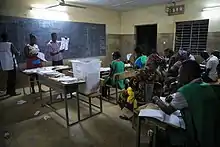
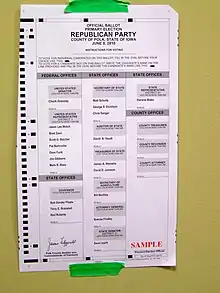

| Part of the Politics series | ||||||||
.svg.png.webp) | ||||||||
| Balloting | ||||||||
|
||||||||
| Electoral systems | ||||||||
|
||||||||
| Voting strategies | ||||||||
|
||||||||
| Voting patterns and effects | ||||||||
|
||||||||
| Electoral fraud | ||||||||
|
||||||||
|
| ||||||||
Counts are simplest in parliamentary systems where just one choice is on the ballot, and these are often counted manually. In other political systems where many choices are on the same ballot, counts are often done by computers to give quick results. Tallies done at distant locations must be carried or transmitted accurately to the central election office.
Manual counts are usually accurate within one percent. Computers are at least that accurate, except when they have undiscovered bugs, broken sensors scanning the ballots, paper misfeeds, or hacks. Officials keep election computers off the internet to minimize hacking, but the manufacturers are on the internet. They and their annual updates are still subject to hacking, like any computers. Further voting machines are in public locations on election day, and often the night before, so they are vulnerable.
Paper ballots and computer files of results are stored until they are tallied, so they need secure storage, which is hard. The election computers themselves are stored for years, and briefly tested before each election.
Manual counting
Manual counting, also known as hand-counting, requires a physical ballot that represents voter intent. The physical ballots are taken out of ballot boxes and/or envelopes, read and interpreted; then results are tallied.[2] Manual counting may be used for election audits and recounts in areas where automated counting systems are used.[3]
Methods
One method of manual counting is to sort ballots in piles by candidate, and count the number of ballots in each pile. If there is more than one contest on the same sheet of paper, the sorting and counting are repeated for each contest.[4] This method has been used in Burkina Faso, Russia, Sweden, United States (Minnesota), and Zimbabwe.[5]
A variant is to read aloud the choice on each ballot while putting it into its pile, so observers can tally initially, and check by counting the piles. This method has been used in Ghana, Indonesia, and Mozambique.[5]
Another approach is for one official to read all the votes on a ballot aloud, to one or more other staff, who tally the counts for each candidate. The reader and talliers read and tally all contests, before going on to the next ballot.[3]
A variant of all approaches is to scan all the ballots and release a file of the images, so anyone can count them. Parties and citizens can count these images by hand or by software. The file gives them evidence to resolve discrepancies.[6] [7] The fact that different parties and citizens count with independent systems protects against errors from bugs and hacks. A checksum for the file identifies true copies.[8] Election machines which scan ballots typically create such image files automatically,[9] though those images can be hacked or be subject to bugs if the election machine is hacked or has bugs. Independent scanners can also create image files. Copies of ballots are known to be available for release in Alabama, Arizona,[10] Humboldt County CA,[11] Michigan,[12] [13] New York State,[14] and Dane County Wisconsin.[15][16] The press obtained copies of many ballots in the 2000 Presidential election in Florida to recount after the Supreme Court halted official recounts.[17] Different methods resulted in different winners.
Timing of manual counts
The tallying may be done at night at the end of the last day of voting, as in Britain,[18] Canada,[19] France,[20] Germany,[21] and Spain,[22] or the next day,[5] or 1–2 weeks later in the US, after provisional ballots have been adjudicated.[23]
If counting is not done immediately, or if courts accept challenges which can require re-examination of ballots, the ballots need to be securely stored, which is problematic.
Errors in manual counts
Hand-counting can be boring, so officials lose track, or they fail to read their own tally sheets correctly at the end of the process. Average errors in candidate tallies in New Hampshire towns were 2.5% from 1946-2002, including one town with errors up to 20%. Omitting that town cut the average error to 0.87%. Only the net result for each candidate in each town could be measured, by assuming the careful manual recount was fully accurate. Total error can be higher if there were countervailing errors hidden in the net result. [24] Errors were smaller in candidate tallies for precincts in Wisconsin recounted in 2011 and 2016. The average net discrepancy was 0.28% of the recount tally in 2011 and 0.18% in 2016.[25] Errors were 3% to 27% for various candidates in a 2016 Indiana race, because the tally sheet labels misled officials into over-counting groups of 5 tally marks, and officials sometimes omitted absentee ballots or double-counted ballots.[26]
Intentional errors are fraud. Close review by observers, if allowed, may detect fraud, and the observers may or may not be believed.[27] If only one person sees each ballot and reads off its choice, there is no check on that person's mistakes. In the US only Massachusetts and the District of Columbia give anyone but officials a legal right to see ballot marks during hand counting.[28] If fraud is detected and proven, penalties may be light or delayed. US prosecution policy since the 1980s has been to let fraudulent winners take office and keep office, usually for years, until convicted,[29] [30] and to impose sentencing level 8-14,[31] which earns less than two years of prison.[32]
Cost of manual counts
Counting took 86 seconds of staff time per vote ($0.36) when Washington State, USA, hand-counted one contest for governor in 2004 on 2,159,831 paper ballots, with a separate sheet of paper for each voter.[33] The work was done in teams of two, one person reading, the second person recording, 43 seconds per vote, including recovery from mistakes, total 86 seconds of staff time.
Counting took 43 seconds of staff time per vote ($0.18) when Clark County, Nevada, USA, hand-counted 21 contests in 2004 on 1,359 ballots with all votes marked by machines on continuous paper tapes.[33]
Counting took 32 seconds of staff time per vote ($0.15) when 3 counties in Georgia, USA, hand-counted about 40 contests in 2006 on 2,038 ballots with all votes marked by machines on continuous paper tapes; Counties ranged from 20–36 seconds per vote.[34]
Counting took 9.6 seconds of staff time per vote ($0.04) when 2 citizens in Wisconsin tallied electronic images for each candidate in 2015, at 100 images per 4 minutes, so 2.4 seconds per image, times 4 citizens needed to tally 2 competing candidates. This does not include time to set up the system and access the files.[35][15]
Optical scan counting
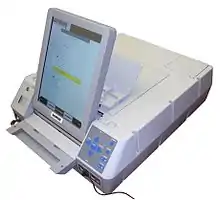
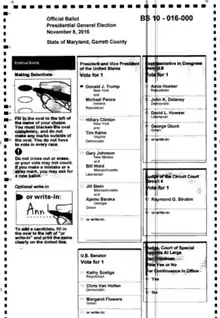
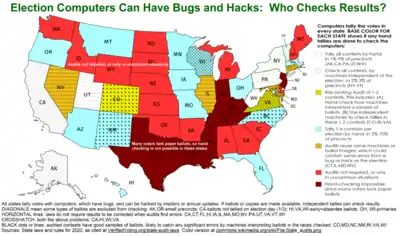
In an optical scan voting system, or marksense, each voter's choices are marked on one or more pieces of paper, which then go through a scanner. The scanner creates an electronic image of each ballot, interprets it, creates a tally for each candidate, and usually stores the image for later review.
The voter may mark the paper directly, usually in a specific location for each candidate.
Or the voter may select choices on an electronic screen, which then prints the chosen names, usually with a bar code or QR code summarizing all choices, on a sheet of paper to put in the scanner.[36] This screen and printer is called an electronic ballot marker (EBM) or ballot marking device (BMD), and voters with disabilities can communicate with it by headphones, large buttons, sip and puff, or paddles, if they cannot interact with the screen or paper directly. Typically the ballot marking device does not store or tally votes. The paper it prints is the official ballot, put into a scanning system which counts the barcodes, or the printed names can be hand-counted, as a check on the machines.[37] Most voters do not look at the paper to ensure it reflects their choices, and when there is a mistake, 93% of voters do not report it to poll workers.[38]
Two companies, Hart and Clear Ballot, have scanners which count the printed names, which voters had a chance to check, rather than bar codes and QR codes, which voters are unable to check.[39]
Timing of optical scans
The machines are faster than hand-counting, so are typically used the night after the election, to give quick results. The paper ballots and electronic memories still need to be stored, to check that the images are correct, and to be available for court challenges.
Errors in optical scans
Scanners have a row of photo-sensors which the paper passes by, and they record light and dark pixels from the ballot. A black streak results when a scratch or paper dust causes a sensor to record black continuously.[40][41] A white streak can result when a sensor fails.[42] In the right place, such lines can indicate a vote for every candidate or no votes for anyone. Some offices blow compressed air over the scanners after every 200 ballots to remove dust.[43]
Software can miscount; if it miscounts drastically enough, people notice and check.
- In a 2019 election in Northampton county, Pennsylvania, the software under-counted one candidate by 99%, reporting 164 votes, compared to 26,142 found in a subsequent hand-count, which changed the candidate's loss to a win.[44]
- In a 2018 New York City election when the air was humid, ballots jammed in the scanner, or multiple ballots went through a scanner at once, hiding all but one.[45]
- In a 2016 Maryland election, a comparison of two scanning systems on the same ballots revealed that (a) 1,972 ballot images were incorrectly left out of one system, (b) one system incorrectly ignored many votes for write-in candidates,[46] (c) shadows from paper folds were sometimes interpreted as names written in on the ballot, (d) the scanner sometimes pulled two ballots at once, scanning only the top one, (e) the ballot printers sometimes left off certain candidates, (f) voters often put a check or X instead of filling in an oval, which software has to adapt to, and (g) a scratch or dirt on a scanner sensor put a black line on many ballot images, causing the appearance of voting for more than the allowed number of candidates, so those votes were incorrectly ignored.[40][41]
- In a 2014 Stoughton, Wisconsin, election, all voters' choices on a referendum were ignored, because the scanner was programmed to look in the wrong spot on the ballot.[43]
- In a 2010 New York election, 20,000 votes for governor and 30,000-40,000 votes for other offices were ignored, because the scanners overheated and disqualified the ballots by reading multiple votes in races where voters had properly only voted once.[47][48][49]
- In a 2004 Yakima, Washington, election 24 voters' choices on 4 races were ignored by a faulty scanner which created a white streak down the ballot.[42]
- In a 2004 Medford, Wisconsin, election, all 600 voters who voted a straight party ticket had all their votes ignored, because the manufacturer forgot to program the machines for a partisan election.[50] Election officials did not notice any problem. The consultant who found the lost 600 voters also reported a Michigan precinct with zero votes, since staff put ballots in the scanner upside down.
- In a 2000 Bernalillo County (Albuquerque area), New Mexico, election, a programming error meant that straight-party votes on paper ballots were not counted for the individual candidates. The number of ballots was thus much larger than the number of votes in each contest. The software was fixed, and the ballots were re-scanned to get correct counts.[51][52]
- In the 2000 Florida presidential race the most common optical scanning error was to treat as an overvote a ballot where the voter marked a candidate and wrote in the same candidate.[24]
- Researchers find security flaws in all election computers, which let voters, staff members or outsiders disrupt or change results, often without detection.[53]
When a ballot marking device prints a bar code or QR code along with candidate names, the candidates are represented in the bar code or QR code as numbers, and the scanner counts those codes, not the names. If a bug or hack makes the numbering system in the ballot marking device not aligned with the numbering system in the scanner, votes will be tallied for the wrong candidates.[39] This numbering mismatch has appeared with direct recording electronic machines (below).[54]
Some US states check a small number of places by hand-counting or use of machines independent of the original election machines.[28]
Recreated ballots
Recreated ballots are paper[55] or electronic[56] ballots created by election staff when originals cannot be counted for some reason. They usually apply to optical scan elections, not hand-counting. Reasons include tears, water damage and folds which prevent feeding through scanners. Reasons also include voters selecting candidates by circling them or other marks, when machines are only programmed to tally specific marks in front of the candidate's name.[57] As many as 8% of ballots in an election may be recreated.[56]
Recreated ballots are sometimes called "reconstructed ballots."[55] The term "duplicate ballot" sometimes refers to these recreated ballots,[58] and sometimes to extra ballots erroneously given to or received from a voter.[59]
Because of its potential for fraud, recreation of ballots is usually done by teams of two people working together[60] or closely observed by bipartisan teams.[55] The security of a team process can be undermined by having one person read to the other, so only one looks at the original votes and one looks at the recreated votes, or by having the team members appointed by a single official.[61]
When auditing an election, audits need to be done with the original ballots, not the recreated ones.
Cost of scanning systems
If most voters mark their own paper ballots and one marking device is available at each polling place for voters with disabilities, Georgia's total cost of machines and maintenance for 10 years, starting 2020, has been estimated at $12 per voter ($84 million total). Pre-printed ballots for voters to mark would cost $4 to $20 per voter ($113 million to $224 million total machines, maintenance and printing). The low estimate includes $0.40 to print each ballot, and more than enough ballots for historic turnout levels. the high estimate includes $0.55 to print each ballot, and enough ballots for every registered voter, including three ballots (of different parties) for each registered voter in primary elections with historically low turnout.[62][63] The estimate is $29 per voter ($203 million total) if all voters use ballot marking devices, including $0.10 per ballot for paper.
The capital cost of machines in 2019 in Pennsylvania is $11 per voter if most voters mark their own paper ballots and a marking device is available at each polling place for voters with disabilities, compared to $23 per voter if all voters use ballot marking devices.[64] This cost does not include printing ballots.
New York has an undated comparison of capital costs and a system where all voters use ballot marking devices costing over twice as much as a system where most do not. The authors say extra machine maintenance would exacerbate that difference, and printing cost would be comparable in both approaches.[65] Their assumption of equal printing costs differs from the Georgia estimates of $0.40 or $0.50 to print a ballot in advance, and $0.10 to print it in a ballot marking device.[62]
Direct-recording electronic counting
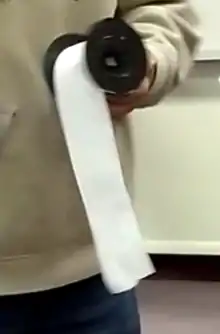
A touch screen displays choices to the voter, who selects choices, and can change their mind as often as needed, before casting the vote. Staff initialize each voter once on the machine, to avoid repeat voting. Voting data and ballot images are recorded in memory components, and can be copied out at the end of the election.
The system may also provide a means for communicating with a central location for reporting results and receiving updates,[66] which is an access point for hacks and bugs to arrive.
Some of these machines also print names of chosen candidates on paper for the voter to verify. These names on paper can be used for election audits and recounts if needed. The tally of the voting data is stored in a removable memory component and in bar codes on the paper tape. The paper tape is called a Voter-verified paper audit trail (VVPAT). The VVPATs can be counted at 20–43 seconds of staff time per vote (not per ballot).[33][34]
For machines without VVPAT, there is no record of individual votes to check.
Errors in direct-recording electronic voting
This approach can have software errors. It does not include scanners, so there are no scanner errors. When there is no paper record, it is hard to notice or research most errors.
- The only forensic examination which has been done of direct-recording software files was in Georgia in 2020, and found that one or more unauthorized intruders had entered the files and erased records of what it did to them. In 2014-2017 an intruder had control of the state computer in Georgia which programmed vote-counting machines for all counties. The same computer also held voter registration records. The intrusion exposed all election files in Georgia since then to compromise and malware. Public disclosure came in 2020 from a court case.[67][68][69] Georgia did not have paper ballots to measure the amount of error in electronic tallies. The FBI studied that computer in 2017, and did not report the intrusion.[70][67]
- A 2018 study of direct-recording voting machines (iVotronic) without VVPAT in South Carolina found that every election from 2010-2018 had some memory cards fail. The investigator also found that lists of candidates were different in the central and precinct machines, so 420 votes which were properly cast in the precinct were erroneously added to a different contest in the central official tally, and unknown numbers were added to other contests in the central official tallies. The investigator found the same had happened in 2010. There were also votes lost by garbled transmissions, which the state election commission saw but did not report as an issue. 49 machines reported that their three internal memory counts disagreed, an average of 240 errors per machine, but the machines stayed in use, and the state evaluation did not report the issue, and there were other error codes and time stamp errors.[54][71]
- In a 2017 York County, Pennsylvania, election, a programming error in a county's machines without VVPAT let voters vote more than once for the same candidate. Some candidates had filed as both Democrat and Republican, so they were listed twice in races where voters could select up to three candidates, so voters could select both instances of the same name.[72] They recounted the DRE machines' electronic records of votes and found 2,904 pairs of double votes.[73]
- In a 2011 Fairfield Township, New Jersey, election a programming error in a machine without a VVPAT gave two candidates low counts. They collected more affidavits by voters who voted for them than the computer tally gave them, so a judge ordered a new election which they won.[74]
- A 2007 study for the Ohio Secretary of State reported on election software from ES&S, Premier and Hart. Besides the problems it found, it noted that all "election systems rely heavily on third party software that implement interfaces to the operating systems, local databases, and devices such as optical scanners... the construction and features of this software is unknown, and may contain undisclosed vulnerabilities such trojan horses or other malware."[75]
Mechanical counting
Mechanical voting machines have voters selecting switches (levers),[76] [77] pushing plastic chips through holes, or pushing mechanical buttons which increment a mechanical counter (sometimes called the odometer) for the appropriate candidate.[2]
There is no record of individual votes to check.
Errors in mechanical counting
Tampering with the gears or initial settings can change counts, or gears can stick when a small object is caught in them, so they fail to count some votes.[78] When not maintained well the counters can stick and stop counting additional votes; staff may or may not choose to fix the problem.[50] Also, election staff can read the final results wrong off the back of the machine.
General issues
Interpretation, in any counting method
Election officials or optical scanners decide if a ballot is valid before tallying it. Reasons why it might not be valid include: more choices selected than allowed; incorrect voter signature or details on ballots received by mail, if allowed; lack of poll worker signatures, if required; forged ballot (wrong paper, printing or security features); stray marks which could identify who cast the ballot (to earn payments); and blank ballots, though these may be counted separately as abstentions.[5]
For paper ballots officials decide if the voter's intent is clear, since voters may mark lightly, or circle their choice, instead of marking as instructed. The ballot may be visible to observers to ensure agreement, by webcam or passing around a table,[5] or the process may be private. In the US only Massachusetts and the District of Columbia give anyone but officials a legal right to see ballot marks during hand counting.[28] For optical scans, the software has rules to interpret voter intent, based on the darkness of marks.[42] Software may ignore circles around a candidate name, and paper dust or broken sensors can cause marks to appear or disappear, not where the voter intended.
Officials also check if the number of voters checked in at the polling place matches the number of ballots voted, and that the votes plus remaining unused ballots matches the number of ballots sent to the polling place. If not, they look for the extra ballots, and may report discrepancies.[5]
Secure storage to enable counts in future
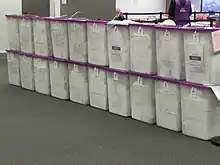

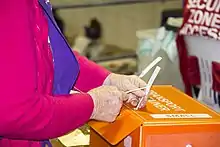
If ballots or other paper or electronic records of an election may be needed for counting or court review after a period of time, they need to be stored securely.
Election storage often uses tamper-evident seals,[79] [80] although seals can typically be removed and reapplied without damage, especially in the first 48 hours.[81] Photos taken when the seal is applied can be compared to photos taken when the seal is opened.[82] Detecting subtle tampering requires substantial training.[81][83][84] Election officials usually take too little time to examine seals, and observers are too far away to check seal numbers, though they could compare old and new photos projected on a screen. If seal numbers and photos are kept for later comparison, these numbers and photos need their own secure storage. Seals can also be forged. Seals and locks can be cut so observers cannot trust the storage. If the storage is breached, election results cannot be checked and corrected.
Experienced testers can usually bypass all physical security systems.[85] Locks[86] and cameras[87] are vulnerable before and after delivery.[85] Guards can be bribed or blackmailed. Insider threats[88][89] and the difficulty of following all security procedures are usually under-appreciated, and most organizations do not want to learn their vulnerabilities.[85]
Security recommendations include preventing access by anyone alone,[90] which would typically require two hard-to-pick locks, and having keys held by independent officials if such officials exist in the jurisdiction; having storage risks identified by people other than those who design or manage the system; and using background checks on staff.[79]
No US state has adequate laws on physical security of the ballots.[91]
Starting the tally soon after voting ends makes it feasible for independent parties to guard storage sites.[92]
Secure transport and internet
The ballots can be carried securely to a central station for central tallying, or they can be tallied at each polling place, manually or by machine, and the results sent securely to the central elections office. Transport is often accompanied by representatives of different parties to ensure honest delivery. Colorado transmits voting records by internet from counties to the Secretary of State, with hash values also sent by internet to try to identify accurate transmissions.[93]
Postal voting is common worldwide, though France stopped it in the 1970s because of concerns about ballot security. Voters who receive a ballot at home may also hand-deliver it or have someone else to deliver it. The voter may be forced or paid to vote a certain way,[27] or ballots may be changed or lost during the delivery process,[94] [95] or delayed so they arrive too late to be counted or for signature mis-matches to be resolved.[96] [97]
Postal voting lowered turnout in California by 3%.[98] It raised turnout in Oregon only in Presidential election years by 4%, turning occasional voters into regular voters, without bringing in new voters.[99] Election offices do not mail to people who have not voted recently, and letter carriers do not deliver to recent movers they do not know, omitting mobile populations.[100]
Some jurisdictions let ballots be sent to the election office by email, fax, internet or app.[101] Email and fax are highly insecure.[102] Internet so far has also been insecure, including in Switzerland,[103] Australia,[104] and Estonia.[105] Apps try to verify the correct voter is using the app by name, date of birth and signature,[106] which are widely available for most voters, so can be faked; or by name, ID and video selfie, which can be faked by loading a pre-recorded video.[107] Apps have been particularly criticized for operating on insecure phones, and pretending to more security during transmission than they have.[108] [109] [107]
See also
References
- https://www.eac.gov/sites/default/files/eac_assets/1/6/EMG_chapt_13_august_26_2010.pdf
- History of Voting Technology from PBS's The NewsHour with Jim Lehrer
- "Post-Election Tabulation Audit Pilot Program Report" (PDF). Maryland State Board of Elections. October 2016. Retrieved 2020-02-14.
- "2018 Post-Election Review Guide" (PDF). Minnesota Secretary of State. 2018-07-19.
- "Country Examples Index —". ACE-Electoral Knowledge Network. Retrieved 2020-02-14.
- "Ballot Image Audit Guide for Candidates and Campaigns" (PDF). AuditElectionsUSA.org/download-guide. 2018-11-26. Retrieved 2020-02-15.
- Lutz, Ray (2017-01-10). "The Open Ballot Initiative" (PDF). OpenBallotInitiative.org. Retrieved 2020-02-15.
- Trachtenberg, Mitch (2013-06-29). "The Humboldt County Election Transparency Project and TEVS" (PDF). Retrieved 2020-02-15.
- "States/Counties that Use Ballot Images from Paper Ballots". AUDIT USA. Retrieved 2020-02-15.
- "Elections Rightfully Belong to The People". AUDIT USA. Retrieved 2020-02-15.
- Zetter, Kim (2008-12-08). "Unique Transparency Program Uncovers Problems with Voting Software". Wired. ISSN 1059-1028. Retrieved 2020-02-15.
- Chris Root, Alice Dreger, and Kepler Domurat-Sousa. "FOIA Reveals Actual Ballots for City Council, Confirming That a Recount Might Have Changed the Outcome". East Lansing Info. Retrieved 2020-02-15.CS1 maint: multiple names: authors list (link)
- Norb, Franz and Mark Cavitt. "Democratic super PAC behind requests for copies of 2016 ballots; municipal clerks rattled". Macomb Daily. Retrieved 2020-02-15.
- Sparling, Nina (2018-04-30). "Win for Election Transparency as Court Rules Ballot Images Are Public Records". Who What Why. Retrieved 2020-02-15.
- McKim, Karen (January 2016). "Using automatically created digital ballot images to verify voting-machine output in Wisconsin" (PDF). Wisconsin Election Integrity. Retrieved 2020-06-25.
- "Election-Auditing". Dane County, WI. Retrieved 2020-06-25.
- "NORC Florida Ballots Project". 2001-12-14. Archived from the original on 2001-12-14. Retrieved 2020-02-15.
- Game, Chris (May 7, 2015). "Explainer: how Britain counts its votes". The Conversation. Retrieved August 16, 2019. Keaveney, Paula (June 8, 2017). "How votes are counted on election night". The Conversation. Retrieved August 16, 2019.
- "Elections, Our Country, Our Parliament". lop.parl.ca. Retrieved August 16, 2019.
- "Qu'est-ce qu'un dépouillement ? - Comment se déroule une journée dans un bureau de vote ? Découverte des institutions - Repères - vie-publique.fr" (in French). January 14, 2018. Retrieved August 16, 2019.
- "Stimmenauszählung". Mülheim an der Ruhr (in German). 2019. Retrieved August 17, 2019.
- "¿Qué es el escrutinio y cómo se cuentan los votos en las elecciones generales 2019?". El Confidencial (in Spanish). April 28, 2019. Retrieved August 17, 2019. and Section 14 of the law:"Ley Orgánica 5/1985, de 19 de Junio, del régimen electoral general. SECCIÓN 14.ª ESCRUTINIO EN LAS MESAS ELECTORALES". www.juntaelectoralcentral.es. Retrieved August 17, 2019.
- "Starting to audit only when all the audit units have already been counted is the most straightforward method." "Principles and Best Practices for Post-Election Tabulation Audits" (PDF). ElectionAudits.org. 2018. Retrieved August 12, 2019.
- Ansolabehere, Stephen, and Andrew Reeves (January 2004). "Using Recounts to Measure the Accuracy of Vote Tabulations: Evidence from New Hampshire Elections 1946-2002" (PDF). CALTECH/MIT Voting Technology Project. Retrieved 2020-02-14.CS1 maint: multiple names: authors list (link)
- Ansolabehere, Stephen; Burden, Barry C.; Mayer, Kenneth R.; Stewart, Charles (2018-03-20). "Learning from Recounts". Election Law Journal: Rules, Politics, and Policy. 17 (2): 100–116. doi:10.1089/elj.2017.0440. ISSN 1533-1296.
- BEILMAN, ELIZABETH. "Jeffersonville City Council At-large recount tally sheets show vote differences". News and Tribune (Jeffersonville, IN). Retrieved 2020-02-14.
- Pickles, Eric (2016-12-27). "Securing the ballot: review into electoral fraud". Cabinet Office, UK. Retrieved 2020-02-14.
- "State Audit Laws". Verified Voting. 2017-02-10. Retrieved 2018-04-02.
- "Federal Prosecution of Election Offenses Eighth Edition". US Department of Justice. December 2017. Retrieved 2020-02-14.
- "Federal Prosecution of Election Offenses". votewell.net. Retrieved 2020-02-14.
- "2018 Chapter 2 PART C - OFFENSES INVOLVING PUBLIC OFFICIALS AND VIOLATIONS OF FEDERAL ELECTION CAMPAIGN LAWS". United States Sentencing Commission. 2018-06-27. Retrieved 2020-02-14.
- "Sentencing Table" (PDF). US Sentencing Commission. 2011-10-26. Retrieved 2020-02-14.
- Theisen, Ellen (2005-06-14). "Cost Estimate for Hand Counting 2% of the Precincts in the U.S." (PDF). VotersUnite.org. Retrieved 2020-02-14.
- "VOTER VERIFIED PAPER AUDIT TRAIL Pilot Project Report" (PDF). Georgia Secretary of State. 2007-04-10. Retrieved 2020-02-15.
- "FOR ELECTION OFFICIALS". Wisconsin Election Integrity. Retrieved 2020-06-25.
- "Ballot Marking Devices". Verified Voting. Retrieved 2020-02-28.
- Cohn, Jennifer (2018-05-05). "What is the latest threat to democracy?". Medium. Retrieved 2020-02-28.
- Bernhard, Matthew, Allison McDonald, Henry Meng, Jensen Hwa, Nakul Bajaj, Kevin Chang, J. Alex Halderman (2019-12-28). "Can Voters Detect Malicious Manipulation of Ballot Marking Devices?" (PDF). Halderman. Retrieved 2020-02-28.
- Perez, Edward, Joy London, Gregory Miller (March 2019). "Georgia State Election Technology Acquisition, Assessing Recent Legislation in Light of Planned Procurement" (PDF). OSET Institute. Retrieved 2020-03-05.
- Walker, Natasha (2017-02-13). "2016 Post-Election Audits in Maryland" (PDF). Elections Advisory Commission. Retrieved 2020-02-27.
- Ryan, Tom and Benny White (2016-11-30). "Transcript of Email on Ballot Images" (PDF). Pima County, AZ. Retrieved 2020-02-15.
- Gideon, John (2005-07-05). "Hart InterCivic Optical-Scan Has A Weak Spot". www.votersunite.org. Retrieved 2020-02-15.
- McKim, Karen; 2015 (2015-02-17). "Unregistered Dust Bunnies May be Voting in Wisconsin Elections: Stoughton Miscount Update". Wisconsin Grassroots Network. Retrieved 2020-06-26.CS1 maint: numeric names: authors list (link)
- Corasaniti, Nick (2019-11-30). "A Pennsylvania County's Election Day Nightmare Underscores Voting Machine Concerns". The New York Times. ISSN 0362-4331. Retrieved 2020-02-15.
- MacDougall, Ian (2018-11-07). "What Went Wrong at New York City Polling Places? It Was Something in the Air. Literally". ProPublica. Retrieved 2020-02-18.
- Lamone, Linda (2016-12-22). "Joint Chairman's Report on the 2016 Post-Election Tabulation Audit" (PDF). Maryland State Board of Elections. Retrieved 2020-02-15.
- Hamilton, Colby (2012-05-09). "Machine Casts Phantom Votes in the Bronx, Invalidating Real Ones: Report". WNYC New York Public Radio. Retrieved 2020-06-26.
- Keefe, Hohn (2011-12-06). "Thousands of NY Votes Tossed Over Ballot Confusion - WNYC". WNYC New York Public Radio. Archived from the original on 2015-03-31. Retrieved 2020-06-26.
- Norden, Larry, and Sundeep Iyer (2011-12-05). "Design Deficiencies and Lost Votes". Brennan Center for Justice. Retrieved 2020-06-26.
- McKim, Karen; 2014 (2014-05-15). "It happens all the time: Interview with the consultant who discovered the Medford miscount". Wisconsin Grassroots Network. Retrieved 2020-06-26.CS1 maint: numeric names: authors list (link)
- Gruley, Bryan, and Chip Cummins (2000-12-16). "Election Day Became a Nightmare, As Usual, for Bernalillo County". Wall Street Journal. ISSN 0099-9660. Retrieved 2020-03-11.
- Baker, Deborah (2004-10-31). "ABQjournal: Contentious 2000 Election Closest in N.M. History". Albuquerque Journal. Retrieved 2020-03-11.
- Blaze, Matt, Harri Hursti , Margaret Macalpine, Mary Hanley, Jeff Moss, Rachel Wehr, Kendal L Spencer, Christopher Ferris (2019-09-26). "DEF CON 27 Voting Machine Hacking Village" (PDF). Defcon. Retrieved 2020-03-11.
- Buell, Duncan (2018-12-23). Analysis of the Election Data from the 6 November 2018 General Election in South Carolina (PDF). League of Women Voters of South Carolina (Report). Retrieved 2020-02-05.
- "observers from both political parties there... ballots have to be recreated in every election for a number of reasons, ranging from damaged mail-in ballots, to early voters who use pencils which can’t be read by ballot tabulators." Jordan, Ben (2018-11-07). "MKE Election Commission responds to criticism". WTMJ TV Milwaukee. Retrieved 2020-05-17.
- "With the new digital procedure, staff will be able to fix whatever race couldn’t be counted, instead of duplicating a voter’s entire ballot." White, Rebecca (2019-11-18). "One Washington County Plans to Speed Vote Counting with Tech". Government Technology. Retrieved 2020-05-17.
- Writer, Steve Miller, Journal Staff (2006-11-07). "Oddly marked ovals bane of poll workers' day". Rapid City Journal. Retrieved 2020-05-17.
- Black, Eric (2008-12-17). "Recount's next big issue: duplicate ballots". MinnPost. Retrieved 2020-05-17.
- Tomasic, Megan (2020-05-14). "Some Allegheny County voters received duplicate mail-in ballots due to system glitch". Tribune Review. Retrieved 2020-05-17.
- Duplicate ballot procedures in Ventura County, CA https://recorder.countyofventura.org/wp-content/uploads/2018/05/BALLOT-DUPLICATION-PROCESS-FACTS-2-Final-1.pdf
- Duplicate ballot procedures in Michigan https://www.michigan.gov/documents/sos/XII_Precinct_Canvass_-_Closing_the_Polls_266013_7.pdf
- Perez, Edward, and Gregory Miller (March 2019). "Georgia State Election Technology Acquisition, A Reality Check". OSET Institute. Retrieved 2020-03-06.
- Fowler, Stephen. "Here's What Vendors Say It Would Cost To Replace Georgia's Voting System". Georgia Public Broadcasting. Retrieved 2020-02-28.
- Deluzio, Christopher, Kevin Skoglund (2020-02-28). "Pennsylvania Counties' New Voting Systems Selections: An Analysis" (PDF). University of Pittsburgh. Retrieved 2020-02-28.
- "NYVV - Paper Ballots Costs". www.nyvv.org. Retrieved 2020-02-28.
- 2005 Voluntary Voting System Guidelines Archived 2006-02-08 at the Wayback Machine from the US Election Assistance Commission
- Lamb, Logan (2020-01-14). "SUPPLEMENTAL DECLARATION OF LOGAN LAMB" (PDF). CourtListener. Retrieved 2020-02-03.
- "Coalition Plaintiffs' Status Report, pages 237-244". Coalition for Good Governance. 2020-01-16. Retrieved 2020-02-03.
- Bajak, Frank (2020-01-16). "Expert: Georgia election server showed signs of tampering". Associated Press. Retrieved 2020-02-03.
- Zetter, Kim. "Will the Georgia Special Election Get Hacked?". Politico. Retrieved 2020-02-16.
- Freed, Benjamin (2019-01-07). "South Carolina voting machines miscounted hundreds of ballots, report finds". Scoop News Group. Retrieved 2020-02-05.
- Kessler, Brandie, Teresa Boeckel and Dylan Segelbaum; Boeckel, Teresa; Segelbaum, Dylan (2017-11-07). "'Redo' of some York County races - including judge - possible after voting problems". York Daily Record. Retrieved 2020-03-11.
- Lee, Rick (2017-11-20). "UPDATE: York Co. election judicial winners: Kathleen Prendergast, Clyde Vedder, Amber Anstine Kraft". York Daily Record. Retrieved 2020-03-11.
- Thibodeau, Patrick (2016-10-05). "If the election is hacked, we may never know". ComputerWorld. Retrieved 2020-02-18.
- McDaniel; et al. (2007-12-07). EVEREST: Evaluation and Validation of Election-Related Equipment, Standards and Testing (PDF) (Report). Retrieved 2020-02-05.
- Shapiro, Eliza (2012-11-10). "RIP, Lever Voting Machines". The Daily Beast. Retrieved 2020-02-16.
- "Vote: The Machinery of Democracy". Smithsonian Institution. Retrieved 2020-02-16.
- Emspak, Jesse (2016-11-08). "Why Not Paper Ballots? America's Weird History of Voting Machines". livescience.com. Retrieved 2020-02-16.
- "Chapter 3. PHYSICAL SECURITY" (PDF). US Election Assistance Commission. Retrieved April 24, 2018.
- Lindeman, Mark (executive editor), Jennie Bretschneider, Sean Flaherty, Susannah Goodman, Mark Halvorson, Roger Johnston, Ronald L. Rivest, Pam Smith, Philip B. Stark (October 1, 2012). "Risk-Limiting Post-Election Audits: Why and How" (PDF). University of California at Berkeley. pp. 3, 16. Retrieved April 9, 2018.
- Johnston, Roger G., and Jon S. Warner (July 31, 2012). "How to Choose and Use Seals". Army Sustainment. Retrieved May 4, 2018.
- Stark, Philip (July 26, 2018). "An Introduction to Risk-Limiting Audits and Evidence-Based Elections Prepared for the Little Hoover Commission" (PDF). University of California, Berkeley. Retrieved August 16, 2019.
- Coherent Cyber, Freeman, Craft McGregor Group (August 28, 2017). "Security Test Report ES&S Electionware 5.2.1.0" (PDF): 9 – via California Secretary of State. Cite journal requires
|journal=(help)CS1 maint: multiple names: authors list (link) - Stauffer, Jacob (November 4, 2016). "Vulnerability & Security Assessment Report Election Systems &Software's Unity 3.4.1.0" (PDF) – via Freeman, Craft, MacGregor Group for California Secretary of State. Cite journal requires
|journal=(help) - Seivold, Garett (April 2, 2018). "Physical Security Threats and Vulnerabilities - LPM". losspreventionmedia.com. Retrieved April 24, 2018.
- There are several sources on lock vulnerabilities:
- Lockpicking is widely taught and practiced: Vanderbilt, Tom (March 12, 2013). "The Strange Things That Happen at a Lock-picking Convention". Slate. Retrieved August 15, 2019.
- Different techniques apply to electronic locks: Menn, Joseph (August 6, 2019). "Exclusive: High-security locks for government and banks hacked by researcher". Reuters. Retrieved August 16, 2019.
- More on electronic locks: Greenberg, Andy (August 29, 2017). "Inside an Epic Hotel Room Hacking Spree". Wired. ISSN 1059-1028. Retrieved August 16, 2019.
- There are no statistics on how often criminals enter rooms undetected, but law enforcement often does so, so ability to enter rooms undetected is widespread: Tien, Lee (October 26, 2014). "Peekaboo, I See You: Government Authority Intended for Terrorism is Used for Other Purposes". Electronic Frontier Foundation. Retrieved August 15, 2019.
- Security camera flaws have been covered extensively:
- Bannister, Adam (October 7, 2016). "How to hack a security camera. It's alarmingly simple". IFSEC Global, Security and Fire News and Resources. Retrieved August 16, 2019.
- Doffman, Zak. "Official Cybersecurity Review Finds U.S. Military Buying High-Risk Chinese Tech (Updated)". Forbes. Retrieved August 14, 2019.
- Schneier, Bruce (October 8, 2007). "Hacking Security Cameras - Schneier on Security". www.schneier.com. Retrieved August 16, 2019.
- Dunn, John (June 11, 2019). "Critical flaws found in Amcrest security cameras". Naked Security. Retrieved August 16, 2019.
- Turner, Karl (November 5, 2007). "Elections board workers take plea deal". Cleveland Plain Dealer. Retrieved August 17, 2019.
- Recount Now (January 11, 2017). "Report on the 2016 Presidential Recount in Clark County, Nevada. Page 20" (PDF). Internet Archive. Archived from the original (PDF) on 2019-08-12. Retrieved August 17, 2019.
- "Principles and Best Practices for Post-Election Tabulation Audits" (PDF). ElectionAudits.org. 2018. Retrieved August 12, 2019.
- Benaloh, Public Evidence from Secret Ballots; et al. (2017). Electronic voting : second International Joint Conference, E-Vote-ID 2017, Bregenz, Austria, October 24–27, 2017, proceedings. Cham, Switzerland. p. 122. ISBN 9783319686875. OCLC 1006721597.
- Organisation for Security and Cooperation in Europe (OSCE) policy calls for independent foreign officials to sleep with ballots, and allows parties to do so:
- International Crisis Group (ICG) (September 10, 1997). "Municipal Elections in Bosnia and Herzegovina". RefWorld. Retrieved August 12, 2019.
- "OHR SRT News Summary, September 7, 1998". Office of the High Representative (Bosnia+Herzegovina). September 7, 1998. Retrieved August 12, 2019.
- "Turkey's opposition sleeping beside ballots to safeguard democracy". Ahval. April 4, 2019. Retrieved August 12, 2019.
- Gall, Carlotta (April 1, 2019). "A Political Quake in Turkey as Erdogan's Party Loses in His Home Base of Support". The New York Times. ISSN 0362-4331. Retrieved August 12, 2019.
- Cobb, Sue (2016-10-17). "The 2000 Presidential Election – The Florida Recount". Association for Diplomatic Studies & Training. Retrieved 2020-03-11.
- Baker, Deborah (2004-10-31). "ABQjournal: Contentious 2000 Election Closest in N.M. History". Albuquerque Journal. Retrieved 2020-03-11.
- "Rule 25. Post-election audit" (PDF). Colorado Secretary of State. Retrieved 2020-02-18.
- "Judge upholds vote-rigging claims". BBC. 2005-04-04. Retrieved 2020-02-18.
- Mawrey, Richard (2010-11-01). "Judgment of Commissioner Mawrey QC Handed down on Monday 4th April 2005 in the matters of Local Government elections for the Bordesley Green and Aston Wards of the Birmingham City Council both held on 10th June 2004". Archived from the original on 2010-11-01. Retrieved 2020-02-18.
- "Thousands of mailed ballots in Florida were not counted". NBC News. Retrieved 2019-03-27.
- "If you vote by mail in Florida, it's 10 times more likely that ballot won't count". miamiherald. Retrieved 2019-03-27.
- Kousser, thad, and Megan Mullin (2007-07-13). "Does Voting by Mail Increase Participation? Using Matching to Analyze a Natural Experiment" (PDF). Political Analysis. 15 (4): 428–445. doi:10.1093/PAN/MPM014. S2CID 33267753. Retrieved 2020-02-18.
- BERINSKY, ADAM J., and NANCY BURNS MICHAEL W. TRAUGOTT (2001). "WHO VOTES BY MAIL? A DYNAMIC MODEL OF THE INDIVIDUALLEVEL CONSEQUENCES OF VOTING-BY-MAIL SYSTEMS" (PDF). Public Opinion Quarterly Volume 65:178–197. Retrieved 2020-02-18.
- Slater, Michael, and Teresa James (2007-06-29). "Vote-by-Mail Doesn't Deliver". NonprofitVote.org. Retrieved 2020-02-18.
- "Electronic Transmission of Ballots". National Conference of State Legislatures. Retrieved 2020-02-18.
- Jefferson, David. "What About Email and Fax?". Verified Voting. Retrieved 2020-02-18.
- Zetter, Kim (2019-02-21). "Experts Find Serious Problems With Switzerland's Online Voting System". Vice. Retrieved 2020-02-18.
- Porup, J. M. (2018-05-02). "Online voting is impossible to secure. So why are some governments using it?". CSO. Retrieved 2020-02-18.
- "Independent Report on E-voting in Estonia - A security analysis of Estonia's Internet voting system by international e-voting experts". Retrieved 2020-02-18.
- Parks, Miles (2020-01-22). "Exclusive: Seattle-Area Voters To Vote By Smartphone In 1st For U.S. Elections". NPR. Retrieved 2020-02-18.
- Jefferson, David (2019-05-01). "What We Don't Know About the Voatz "Blockchain" Internet Voting System" (PDF). University of South Carolina. Retrieved 2020-02-18.
- Zetter, Kim (2020-02-13). "'Sloppy' Mobile Voting App Used in Four States Has 'Elementary' Security Flaws". Vice. Retrieved 2020-02-18.
- Specter, Michael A., James Koppel, Daniel Weitzner (2020-02-12). "The Ballot is Busted Before the Blockchain: A Security Analysis of Voatz, the First Internet Voting Application Used in U.S. Federal Elections" (PDF). MIT. Retrieved 2020-02-18.
External links
- The Election Technology Library research list – a comprehensive list of research relating to technology use in elections
- E-Voting information from ACE Project
- AEI-Brookings Election Reform Project
- Electronic Voting Systems at Curlie
- Voting and Elections by Douglas W. Jones: Thorough articles about the history and problems with Voting Machinery
- Selker, Ted Scientific American Magazine Fixing the Vote October 2004
- The Machinery of Democracy: Voting System Security, Accessibility, Usability, and Cost from Brennan Center for Justice at NYU School of Law
- An index of articles on vote counting from the ACE Project guide to designing and administering elections